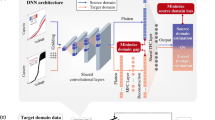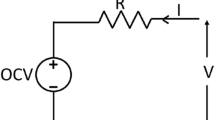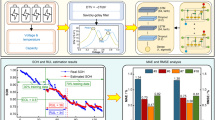Abstract
Battery state of health (SOH) estimation is imperative for preventive maintenance, replacement, and end-of-life prediction of lithium ion batteries. Herein, we introduce a data-driven approach to state of health (SOH) prediction for battery cells using a Deep Neural Network (DNN). Our DNN model, trained on short discharge curve segments, outperforms Multilayer Perceptron (MLP) and Support Vector Regression (SVR) models. The Mutual Information (MI) score guides the selection of voltage range and width for model training, reflecting nonlinear degradation characteristics. A transfer learning strategy is applied for outlier cells, initially training on normal cells and fine-tuning with outlier cells, resulting in improved SOH predictions, particularly at higher cycles. The study finds that increasing the segment width reduces SOH prediction error, with the smallest segment of 0.05 V demonstrating good performance (RMSE of 0.0246), decreasing to 0.0142 at a width of 0.2 V. For outlier cells, transfer learning leads to a 48% reduction in RMSE. The partial segment-based approach offers potential for rapid SOH prediction in laboratory and field applications, enhancing efficiency in the development process.









Similar content being viewed by others
References
Schmuch, R., et al. (2018). Performance and cost of materials for lithium-based rechargeable automotive batteries. Nature Energy, 3(4), 267–278.
Pinson, M. B., & Bazant, M. Z. (2013). Theory of SEI formation in rechargeable batteries: Capacity fade, accelerated aging and lifetime prediction. Journal of the Electrochemical Society, 160(2), A243–A250.
Christensen, J., & Newman, J. (2005). Cyclable lithium and capacity loss in Li-ion cells. Journal of the Electrochemical Society, 152(4), A818–A829.
Lombardo, T., et al. (2022). Artificial intelligence applied to battery research: Hype or reality? Chemical Reviews, 122(12), 10899–10969.
Li, W. H., et al. (2021). Online capacity estimation of lithium-ion batteries with deep long short-term memory networks. Journal of Power Sources, 482, 228863.
Sulzer, V., et al. (2021). The challenge and opportunity of battery lifetime prediction from field data. Joule, 5(8), 1934–1955.
Nejad, S., Gladwin, D. T., & Stone, D. A. (2016). A systematic review of lumped-parameter equivalent circuit models for real-time estimation of lithium-ion battery states. Journal of Power Sources, 316, 183–196.
Keil, J., & Jossen, A. (2020). Electrochemical modeling of linear and nonlinear aging of lithium-ion cells. Journal of the Electrochemical Society, 167(11), 110535.
Ng, M. F., et al. (2020). Predicting the state of charge and health of batteries using data-driven machine learning. Nature Machine Intelligence, 2(3), 161–170.
Severson, K. A., et al. (2019). Data-driven prediction of battery cycle life before capacity degradation. Nature Energy, 4(5), 383–391.
Tao, L. F., et al. (2017). A review of stochastic battery models and health management. Renewable & Sustainable Energy Reviews, 80, 716–732.
Chu, A., et al. (2020). Stochastic capacity loss and remaining useful life models for lithium-ion batteries in plug-in hybrid electric vehicles. Journal of Power Sources, 478, 228991.
Xu, X., et al. (2019). State-of-health estimation for lithium-ion batteries based on wiener process with modeling the relaxation effect. IEEE Access, 7, 105186–105201.
Feng, H. L., & Yan, H. M. (2022). State of health estimation of large-cycle lithium-ion batteries based on error compensation of autoregressive model. Journal of Energy Storage, 52, 104869.
Lin, M. Q., Zeng, X. P., & Wu, J. (2021). State of health estimation of lithium-ion battery based on an adaptive tunable hybrid radial basis function network. Journal of Power Sources, 504, 230063.
Kim, S. W., et al. (2022). Recent advances of artificial intelligence in manufacturing industrial sectors: A review. International Journal of Precision Engineering and Manufacturing, 23, 111–129.
Kim, E., et al. (2023). Data-driven methods for predicting the state of health, state of charge, and remaining useful life of li-ion batteries: A comprehensive review. International Journal of Precision Engineering and Manufacturing, 24, 1281–1304.
Klass, V., Behm, M., & Lindbergh, G. (2014). A support vector machine-based state-of-health estimation method for lithium-ion batteries under electric vehicle operation. Journal of Power Sources, 270, 262–272.
Shao, L. Y., et al. (2023). A review of remaining useful life prediction for energy storage components based on stochastic filtering methods. Energies, 16(3), 1469.
Roman, D., et al. (2021). Machine learning pipeline for battery state-of-health estimation. Nature Machine Intelligence, 3(5), 447–456.
Shi, M. J., Xu, J., Lin, C. P., & Mei, X. S. (2022). A fast state-of-health estimation method using single linear feature for lithium-ion batteries. Energy, 256, 124652.
Birkl, C. (2017). Oxford Battery Degradation Dataset 1, U.o. Oxford, Editor.
Shen, S., et al. (2020). Deep convolutional neural networks with ensemble learning and transfer learning for capacity estimation of lithium-ion batteries. Applied Energy, 260, 114296.
Eddahech, A., et al. (2012). Behavior and state-of-health monitoring of Li-ion batteries using impedence spectroscopy and recurrent neural networks. International Journal of Electrical Power & Energy Systems, 42(1), 487–494.
Lin, M., Wu, J., Meng, J., Wang, W., & Wu, J. (2023). State of health estimation with attentional long short-term memory network for lithium-ion batteries. Energy, 268, 126706.
Bao, X. Y., et al. (2023). Hybrid deep neural network with dimension attention for state-of-health estimation of lithium-ion batteries. Energy, 278, 127734.
Meng, Z., et al. (2023). PINN-FORM: A new physics-informed neural network for reliability analysis with partial differential equation. Computer Methods in Applied Mechanics and Engineering, 414, 116172.
Hofmann, T., et al. (2023). Physics-informed neural networks for state of health estimation in lithium-ion batteries. Journal of the Electrochemical Society, 170(9), 090524.
Murphy, K. P. (2022). Probabilistic machine learning: An introduction. MIT Press.
Pan, S. J., & Yang, Q. A. (2010). A survey on transfer learning. IEEE Transactions on Knowledge and Data Engineering, 22(10), 1345–1359.
Toyota Research Institute Experimental Data Platform. 2019.
Wan, X., Wang, W. Q., Liu, J. M., & Tong, T. J. (2014). Estimating the sample mean and standard deviation from the sample size, median, range and/or interquartile range. BMC Medical Research Methodology, 14, 135.
Gommers, R. (2023). Available from: https://docs.scipy.org/doc/scipy/reference/generated/scipy.interpolate.InterpolatedUnivariateSpline.html
Shu, X., et al. (2021). State of health prediction of lithium-ion batteries based on machine learning: Advances and perspectives. Iscience, 24(11), 103265.
Acknowledgements
This research was supported by the Basic Science Research Program through the National Research Foundation of Korea (NRF) funded by the Ministry of Education (2020R1I1A3073674) and Korea Institute of Energy Technology Evaluation and Planning (KETEP) and the Ministry of Trade, Industry & Energy (MOTIE) of the Republic of Korea (No. 20224000000150).
Author information
Authors and Affiliations
Corresponding author
Ethics declarations
Conflict of interest
There are no conflicts of interest to declare.
Additional information
Publisher's Note
Springer Nature remains neutral with regard to jurisdictional claims in published maps and institutional affiliations.
Supplementary Information
Below is the link to the electronic supplementary material.
Rights and permissions
Springer Nature or its licensor (e.g. a society or other partner) holds exclusive rights to this article under a publishing agreement with the author(s) or other rightsholder(s); author self-archiving of the accepted manuscript version of this article is solely governed by the terms of such publishing agreement and applicable law.
About this article
Cite this article
Javaid, M.U., Seo, J., Suh, YK. et al. Battery State of Health Estimation from Discharge Voltage Segments Using an Artificial Neural Network. Int. J. of Precis. Eng. and Manuf.-Green Tech. (2024). https://doi.org/10.1007/s40684-024-00602-2
Received:
Revised:
Accepted:
Published:
DOI: https://doi.org/10.1007/s40684-024-00602-2




